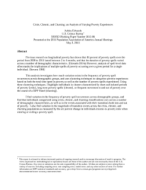
An official website of the United States government
Here’s how you know
Official websites use .gov
A .gov website belongs to an official government organization in the United States.
Secure .gov websites use HTTPS
A lock (
) or https:// means you’ve safely connected to the .gov website. Share sensitive information only on official, secure websites.
-
//
- Census.gov /
- Library /
- Census Working Papers /
- Crisis, Chronic & Churning: an Analysis of Varying Poverty Experiences
Crisis, Chronic, and Churning: an Analysis of Varying Poverty Experiences
Crisis, Chronic, and Churning: an Analysis of Varying Poverty Experiences
Crisis, Chronic, and Churning: an Analysis of Varying Poverty Experiences
Previous research on longitudinal poverty has shown that 44 percent of poverty spells over the period from 2009 to 2011 lasted between 2 to 4 months, and that the duration of poverty spells varied across a number of demographic characteristics. (Edwards 2014a) However, analysis of spell-level data often masks the implications of multiple spells of poverty occurring over a given period for a single individual. (Stevens 1994)
This analysis investigates how much variation exists in the frequency of poverty spell occurrences across demographic groups, and uses clustering techniques to categorize poverty experiences based on both the total time spent in poverty as well as the number of poverty spells experienced. Using these clustering techniques, I highlight individuals in clusters characterized by short and isolated periods of poverty (crisis), long-term poverty spells (chronic), or frequent movement in and out of poverty over the course of a SIPP Panel (churning).
I find variation in the frequency of poverty spell occurrences across demographic groups, and find that individuals categorized using crisis, chronic, and churning classifications vary across a number of demographic characteristics, as well as in the events associated with their transitions both into and out of poverty. I also find variation in the magnitude of transition events across the crisis, chronic, and churning populations as measured by the arc percent change in individuals income-to-poverty ratio when entering or exiting a poverty spell.
Share
Some content on this site is available in several different electronic formats. Some of the files may require a plug-in or additional software to view.
 Yes
Yes
 No
NoComments or suggestions?


Top

